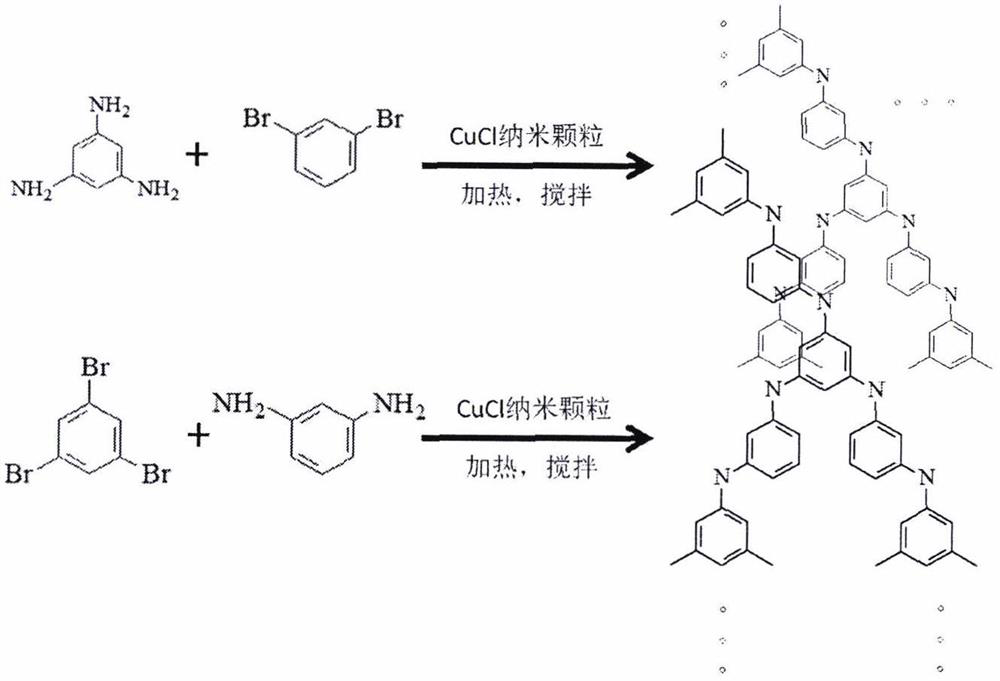A kind of preparation method of nitrogen-doped porous carbon material
A nitrogen-doped porous carbon and reaction technology, which is applied in the preparation/purification of carbon, etc., can solve the problems of high cost, the template method is not suitable for large-scale production, and the nitrogen atom doping process is complicated.
- Summary
- Abstract
- Description
- Claims
- Application Information
AI Technical Summary
Problems solved by technology
Method used
Image
Examples
Embodiment 1
[0025] (1) Weigh 0.8524g of copper chloride dihydrate, place it in a 50mL polytetrafluoroethylene-lined autoclave, add 25mL of ethanol, mix well, and cover the kettle tightly.
[0026] (2) Put the autoclave in a muffle furnace and react at 160°C for 24h. Cool to room temperature, filter under reduced pressure, and dry the product in vacuum at 50°C for 12 hours. Store in a dark place under a nitrogen protection atmosphere to obtain cuprous chloride nanocrystals with a diameter of 2-10 nm.
[0027] (3) 0.025g of cuprous chloride crystal powder, 0.246g of 1,4-dibromobenzene and 0.123g of 1,3,5-triaminobenzene were dissolved in 5.0mL of acetonitrile, nitrogen was added to form a protective atmosphere, and the temperature Maintained at 80°C, refluxed for 12h.
[0028] (4) The reaction mixture was taken out, washed with 25% ammonia water, water and acetone respectively, and dried and stored.
[0029] figure 1 A schematic diagram of the preparation of a covalent organic framework...
Embodiment 2
[0033] (1) Weigh 0.8524g of copper chloride dihydrate, place it in a 50mL polytetrafluoroethylene-lined autoclave, add 25mL of ethanol, mix well, and cover the kettle tightly.
[0034] (2) Put the autoclave in a muffle furnace and react at 160°C for 24h. Cool to room temperature, filter under reduced pressure, and dry the product in vacuum at 50°C for 12 hours. Store in a dark place under a nitrogen protection atmosphere to obtain cuprous chloride nanocrystals with a diameter of 2-10 nm.
[0035] (3) 0.025g of cuprous chloride crystal powder, 0.246g of 1,4-dibromobenzene and 0.123g of 1,3,5-triaminobenzene were dissolved in 5.0mL of acetonitrile, nitrogen was added to form a protective atmosphere, and the temperature Maintained at 120°C, refluxed for 10h.
[0036] (4) The reaction mixture was taken out, washed with 25% ammonia water, water and acetone respectively, and dried and stored.
Embodiment 3
[0038] (1) Weigh 0.8524g of copper chloride dihydrate, place it in a 50mL polytetrafluoroethylene-lined autoclave, add 25mL of ethanol, mix well, and cover the kettle tightly.
[0039] (2) Put the autoclave in a muffle furnace and react at 160°C for 24h. Cool to room temperature, filter under reduced pressure, and dry the product in vacuum at 50°C for 12 hours. Store in a dark place under a nitrogen protection atmosphere to obtain cuprous chloride nanocrystals with a diameter of 2-10 nm.
[0040] (3) 0.025g of cuprous chloride crystal powder, 0.236g of 1,4-dibromobenzene and 0.249g of 2,4,6-triethylbenzene-1,3,5-trimethylamine were dissolved in 5.0mL of acetonitrile , nitrogen was added to form a protective atmosphere, the temperature was maintained at 120 ° C, and reflux was performed for 10 h.
[0041] (4) The reaction mixture was taken out, washed with 25% ammonia water, water and acetone respectively, and dried and stored.
PUM
| Property | Measurement | Unit |
|---|---|---|
| size | aaaaa | aaaaa |
Abstract
Description
Claims
Application Information
 Login to View More
Login to View More - R&D
- Intellectual Property
- Life Sciences
- Materials
- Tech Scout
- Unparalleled Data Quality
- Higher Quality Content
- 60% Fewer Hallucinations
Browse by: Latest US Patents, China's latest patents, Technical Efficacy Thesaurus, Application Domain, Technology Topic, Popular Technical Reports.
© 2025 PatSnap. All rights reserved.Legal|Privacy policy|Modern Slavery Act Transparency Statement|Sitemap|About US| Contact US: help@patsnap.com



